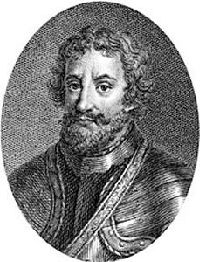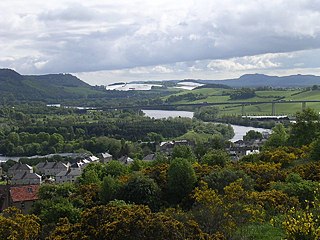Related Research Articles

Macbeth was King of Scots from 1040 until his death. He ruled over the Kingdom of Alba.
Cináed mac Duib, anglicised as Kenneth III, and nicknamed An Donn, "the Chief" or "the Brown", was King of Scots from 997 to 1005. He was the son of Dub. Many of the Scots sources refer to him as Giric son of Kenneth son of Dub, which is taken to be an error. An alternate explanation is that Kenneth had a son, Giric, who ruled jointly with his father.
In early medieval Scotland, a mormaer was the Gaelic name for a regional or provincial ruler, theoretically second only to the King of Scots, and the senior of a Toísech (chieftain). Mormaers were equivalent to English earls or Continental counts, and the term is often translated into English as 'earl'.
The Earl of Fife or Mormaer of Fife was the ruler of the province of Fife in medieval Scotland, which encompassed the modern counties of Fife and Kinross. Due to their royal ancestry, the earls of Fife were the highest ranking nobles in the realm, and had the right to crown the king of Scots.
Causantín or Constantine of Fife is the first man known for certain to have been Mormaer of Fife.
Donnchad II, anglicized as Duncan II or Dunecan II, succeeded his father Duncan I as Earl of Fife in childhood. As a child of the previous mormaer, he was entitled to succeed his father through primogeniture, but not to lead his kin-group, Clann MacDuib. That probably fell to his cousin, Aed mac Gille Míchéil. Like previous mormaers of Fife, Duncan II was appointed Justiciar of Scotia. Donnchad's minority also meant that Ferchar, Mormaer of Strathearn, took supreme place as head of the Gaelic nobility and guide for the boy-king Malcolm IV.
Donnchadh III or Duncan was Earl of Fife from 1270/2 to 1288.
The Kingdom of Alba was the Kingdom of Scotland between the deaths of Donald II in 900 and of Alexander III in 1286, which then led indirectly to the Scottish Wars of Independence. The name is one of convenience, as throughout this period the elite and populace of the Kingdom were predominantly Pictish-Gaels or later Pictish-Gaels and Scoto-Norman, and differs markedly from the period of the House of Stuart, in which the elite of the kingdom were speakers of Middle English, which later evolved and came to be called Lowland Scots. There is no precise Gaelic equivalent for the English terminology "Kingdom of Alba", as the Gaelic term Rìoghachd na h-Alba means 'Kingdom of Scotland'. English-speaking scholars adapted the Gaelic name for Scotland to apply to a particular political period in Scottish history during the High Middle Ages.

Scotland in the Middle Ages concerns the history of Scotland from the departure of the Romans to the adoption of major aspects of the Renaissance in the early sixteenth century.
Mormaer Beth is a name of a Mormaer mentioned in an unreliable charter granted to Scone Priory, later Scone Abbey, by king Alexander I of Scotland.
Scottish legal institutions in the High Middle Ages are, for the purposes of this article, the informal and formal systems which governed and helped to manage Scottish society between the years 900 and 1288, a period roughly corresponding with the general European era usually called the High Middle Ages. Scottish society in this period was predominantly Gaelic. Early Gaelic law tracts, first written down in the ninth century reveal a society highly concerned with kinship, status, honour and the regulation of blood feuds. The early Scottish lawman, or Breitheamh, became the Latin Judex; the great Breitheamh became the magnus Judex, which arguably developed into the office of Justiciar, an office which survives to this day in that of Lord Justice General. Scottish common law began to take shape at the end of the period, assimilating Gaelic and Celtic law with practices from Anglo-Norman England and the Continent.

The High Middle Ages of Scotland encompass Scotland in the era between the death of Domnall II in 900 AD and the death of King Alexander III in 1286, which was an indirect cause of the Wars of Scottish Independence.
The Meic Uilleim (MacWilliams) were the Gaelic descendants of William fitz Duncan, grandson of Máel Coluim mac Donnchada, king of Scots. They were excluded from the succession by the descendants of Máel Coluim's son David I during the 12th century and raised a number of rebellions to vindicate their claims to the Mormaerdom of Moray and perhaps to the rule of Scotland.

Political and military events in Scotland during the reign of David I are the events which took place in Scotland during David I of Scotland's reign as King of Scots, from 1124 to 1153. When his brother Alexander I of Scotland died in 1124, David chose, with the backing of Henry I of England, to take the Kingdom of Alba for himself. David was forced to engage in warfare against his rival and nephew, Máel Coluim mac Alaxandair. Subduing the latter took David ten years, and involved the destruction of Óengus, mormaer of Moray. David's victory allowed him to expand his control over more distant regions theoretically part of the Kingdom. In this he was largely successful, although he failed to bring the Earldom of Orkney into his kingdom.

The Davidian Revolution is a name given by many scholars to the changes which took place in the Kingdom of Scotland during the reign of David I (1124–1153). These included his foundation of burghs, implementation of the ideals of Gregorian Reform, foundation of monasteries, Normanisation of the Scottish government, and the introduction of feudalism through immigrant Norman and Anglo-Norman knights.

Gowrie is a region in central Scotland and one of the original provinces of the Kingdom of Alba. It covered the eastern part of what became Perthshire. It was located to the immediate east of Atholl, and originally included the area around Perth, though that was later detached as Perthia.
Thane was the title given to a local royal official in medieval eastern Scotland, equivalent in rank to the son of an earl, who was at the head of an administrative and socio-economic unit known as a thanedom.

Scottish society in the Middle Ages is the social organisation of what is now Scotland between the departure of the Romans from Britain in the fifth century and the establishment of the Renaissance in the early sixteenth century. Social structure is obscure in the early part of the period, for which there are few documentary sources. Kinship groups probably provided the primary system of organisation and society was probably divided between a small aristocracy, whose rationale was based around warfare, a wider group of freemen, who had the right to bear arms and were represented in law codes, above a relatively large body of slaves, who may have lived beside and become clients of their owners.

Government in medieval Scotland, includes all forms of politics and administration of the minor kingdoms that emerged after the departure of the Romans from central and southern Britain in the fifth century, through the development and growth of the combined Scottish and Pictish kingdom of Alba into the kingdom of Scotland, until the adoption of the reforms of the Renaissance in the fifteenth century.
The Provinces of Scotland were the primary subdivisions of the early Kingdom of Alba, first recorded in the 10th century and probably developing from earlier Pictish territories. Provinces were led by a mormaer, the leader of the most powerful provincial kin-group, and had military, fiscal and judicial functions. Their high degree of local autonomy made them important regional powerbases for competing claimants to the throne of Alba.
References
- Bannerman, John, “The Kings Poet”, in The Scottish Historical Review, V. LXVIII, (1989)
- Barrow, G. W. S., The Kingdom of the Scots, (Edinburgh, 2003)
- Barrow, G. W. S., Kingship and Unity: Scotland, 1000–1306, (Edinburgh. 1981)
- Barrow, G. W. S., Robert Bruce and the Community of the Realm of Scotland, (Edinburgh, 1988)
- Broun, Dauvit, The Charters of Gaelic Scotland and Ireland in the Early and Central Middle Ages, Quiggin Pamphlet no.2., (Cambridge. 1995)
- Grant, Alexander, "Thanes and Thanages, from the eleventh to the Fourteenth Centuries" in A. Grant & K.Stringer (eds.) Medieval Scotland: Crown, Lordship and Community, Essays Presented to G.W.S. Barrow, (Edinburgh, 1993), pp. 39–81
- Kelly, Fergus, Early Irish Law, (Dublin, 1998)
- Lynch, Michael, Scotland: A New History, (Edinburgh, 1992)
- MacQueen, Hector, "Laws and Languages: Some Historical Notes from Scotland", vol 6.2 Electronic Journal of Comparative Law, (July 2002) *
- Neville, Cynthia J., Native Lorship in Medieval Scotland: The Earldoms of Strathearn and Lennox, c. 1140–1365, (Portland/Dublin, 2005)
- Sellar, D. H. S. "Gaelic Laws and Institutions", (2001), in M. Lynch (ed.) The Oxford Companion to Scottish History, (New York, 2001), pp. 381–2